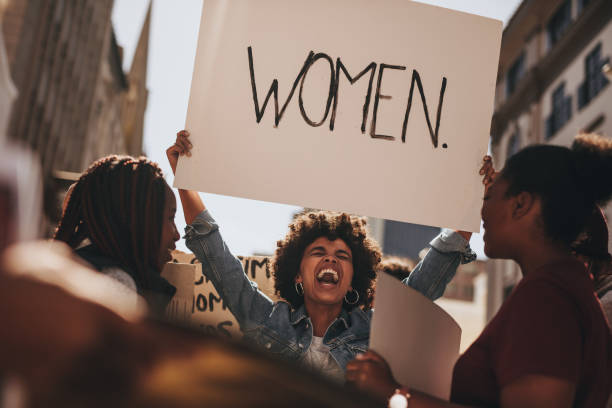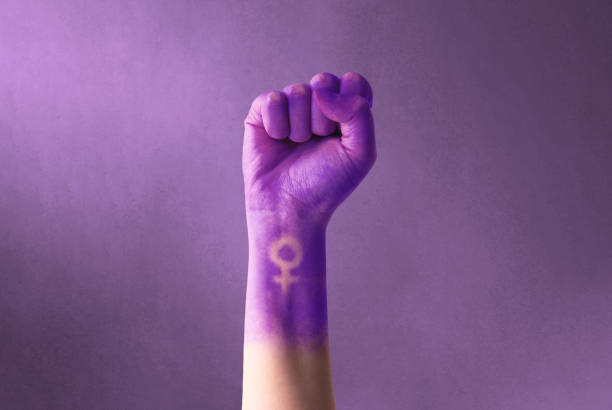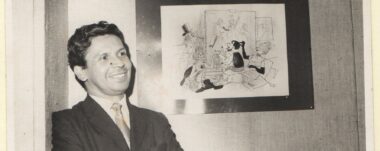THE EVOLUTION OF HUMAN RIGHTS

History of the historical evolution of human rights and the role of women throughout history.

What has been the role of women in these?
The broad historical trajectory on the foundation of Human Rights (HR), from its different visions, has been strongly subjugated by the predominant discourses of societies. It is precisely because of these predominant voices that the voices of different representative groups that did not fit, for example, women, people of African descent, indigenous people, people of diverse sexual orientation, and others, have been minimized.
That is to say, those who were not constituted under the stereotypes regulated by the heteronormative, racist and sexist patriarchy (who was not a white, upper class and cisgender man), was not necessarily contemplated within the social structures; here including the Law. Thus, it is thanks to the multiple social struggles throughout human history, that little by little we begin to break this systematic fixation of discrimination and inequality to build societies and structures more equitable, free, egalitarian and, above all, dignified.
What is a Human Right?
There are various definitions of what can constitute a “Human Right”; and even, certain ‘generations’ of Human Rights have been determined by doctrine, depending on the specific contexts in which each type emerges. Using the words of Pacheco Gomez:
Every human person has rights by virtue of being human and these must be recognized and guaranteed by the State without any social, economic, legal, political, ideological, cultural, or sexual discrimination. But, at the same time, I want to emphasize that these rights are fundamental, that is, they are linked to the idea of dignity of the human person.
Consequently, it can be understood that there has not been, nor will there be, an unequivocal conception of Human Rights and all that they imply. As Bobbio (1964) mentions: “One should not speak of a single foundation, but of foundations of the rights of man, of different foundations.”
In other words, progress in human dignity is what has manifested what is considered a right of any person, of any human; this is by the political, economic, religious, and other relationships that outline the existence of Human Rights in a dynamic way.
It can be understood, then, that the normative and doctrinal evolution of Human Rights (HR), has not necessarily been contemplating figures different from the cisgender white man; on the contrary, the people different to that stereotype have had to be included very recently to the regulations on human rights and international instruments.
It has almost “forced” the analysis, those shortcomings, and failures of historical inclusion. This is because the original concept of “human dignity” was relative to the rights of men, created by men and for men. Ergo, the primordial concept of a “Human Right” was called the “Right of Man”; even today there are those who refer to Human Rights as Man’s Rights, due to this historical notion.
How have women been excluded in the evolutionary history of Human Rights?
According to Peces Barba: “Any attempt at a rational foundation of rights must take into account this historical start, from dissent, with the legal and political situation of the absolute State.” In this way, talking about the evolution of Human Rights is inseparable from the historical context; at the level of political-philosophical, economic, and cultural ideologies that circumscribe Human Rights.
Firstly, in Roman times, due to the deeply rooted culture of limiting women, that they were not even considered as people capable of thinking or feeling, of doing the same thing that a man could do and other ideas, the concept of a human right was reduced to: ‘rights of the free man’. In this case, we’re talking about the paters (patricians or patriarchs) in Rome, which even originates the notion of Patriarchy (power in the hands of the paters).
Later, in the Feudalism epoch, the rights of the lords (feudals), not only constitutes the same notion of “Men in Power”, but economic tenure is emphasized (generating class patriarchy). If we advance a few more centuries, one of the most radical revolutions (the French Revolution), culminated with the Declaration of the Rights of Man and Citizen (1789); one of the oldest regulations where Human Rights are circumscribed or “positivized”.
This classic normative text, which laid the foundations for numerous rights adopted globally by modern States, tacitly excludes women. How? This declaration refers to the rights of all men (although it is also questionable due to the exclusion of black men) and, in general, the rights of citizens. In neither of these two assumptions (man and citizen) fits the female figure.

To counter the “it’s the use of language” critique, in this precise context, women weren’t really included at all, and it wasn’t a mere use of language. It is not, therefore, the sexist use of language, but it transcended the true exclusion of women; despite, even, the help that many offered to men during the Revolution, such as Jeanne d’Arc.
For this reason, this other example is evident in which the evolution of human rights does nothing more than contemplate those voices with power and dominance, and that if the predominant ideology on dignity, which in this case was the one that permeated under the motto of “liberté, égalité et fraternité”, deliberately excluded certain groups due to sexist and racist issues, rights would be positivized according to these ideals.
The Declaration manifested the deep-rooted culture of patriarchy
The Declaration manifested the entrenched culture of patriarchy, to the point of ignoring the struggle of women alongside men and also silencing those who made it known (by sending them to the guillotine). The figure of Olympe de Gouges stands out; se was a woman who decided to oppose this patriarchal structure and re-write the same declaration but from the claim for the dignity of women, obtaining as a result, her murder.
“Olympe was undoubtedly a premature precursor to the category of gender, but her fight was the defense of the political rights of women” (Gloria Ramírez, p.4, 2015). Just like Olympe, women in different social movements have fought to reclaim that corresponding dignity that most men pretended to ignore.
Another example, closer to a current context, is that of suffragettes in Europe and Oceania (the first places where the feminist movement in several countries managed to win the female vote). The right to vote and, in itself, the power of suffrage as a human right of a civil and political nature, was not born contemplated as a fundamental right for minorities (women, enslaved men, indigenous people…)
“Therefore, it is not a question of eternal demands, but only of historical rights, manifestations of the needs of this or that time, and attempts to satisfy these needs”(Benedetto Croce, p.143, 1976).That is to say, the socio-historical transformations will be those that reflect the need to correct the shortcomings provided by the dominant structures of the moment in which a certain right is provided. This is where the inclusion of women’s human rights comes into play, not only to white, European, or upper-class women; but, to all women, even beyond the consideration of biological sex (including here trans women).
“Any attempt at a rational foundation of rights must take into account this historical start, from dissent, with the legal and political situation of the absolute State.”
“Therefore, it is not a question of eternal demands, but only of historical rights, manifestations of the needs of this or that time, and attempts to satisfy these needs“.
The outlook for women in the future of Human Rights
Hélène Cixous reflected in various works, the need for the recognition of women in historical texts and in the doctrine of all areas: law, economics, politics, science, and technology, among others. “The woman, taking for herself the opportunity to speak (…) can break into history (…) in her own right, in all symbolic systems and political processes”. It is in this way that the struggle for Human Rights has been reflected, especially those related to women and other groups.
Currently, more women are joining the claim for political spaces and human rights, evidenced in something like the creation of UN Women, in July 2010. Increasingly, female figures take power in various areas of life; in addition to that, international regulations have been created to indicate the importance of proper protection and recognition of those Human Rights related to women.
There are different conventions/treaties, organizations, and others that have emphasized the human rights of women. To mention a few examples:
- The Convention on the Political Rights of Women (1952)
- The Convention on the Elimination of all Forms of Discrimination Against Women (1979)
- The Inter-American Convention to Prevent, Punish and Eradicate Violence Against Women (Belem do Pará, 1994)
“Human rights exist and are possessed by the subject regardless of whether or not they are recognized by positive law” (Fernández-Galiano, p.150). That is why there are specialized rules for the protection of particular Human Rights because even though they were not considered within the initial Human Rights, or national laws, it does not mean that they do not exist.
When an individual right overlaps the collective plane, formal recognition of the respective reality of these rights is more feasible. In this way, continuing to recognize the particularities of women, whose rights are ignored, as well as other vulnerable groups, will allow the further development of human rights and global mechanisms that support and guarantee this protection.
It is still necessary to fight for intersectionality, recognizing all women and their respective challenges; for example black, indigenous, oriental, trans, and queer women, to continue developing the Human Rights of each person in a more complex way.
SUMMARY OF IMPORTANT POINTS
- There is no single concept of Human Rights since it responds to historical realities and adopts a different conceptualization according to social paradigms.
- The first notions about Human Rights, were specifically of men (especially white and upper class), which influenced the positivization or formalization of the rights of men and citizens from this stereotype; in this way, leaving out other men, women, and above all those who did not meet racial or economic requirements either.
- Currently, many women continue to struggle to insert themselves in each field and claim their rights and those of all women. Different treaties and international organizations have a positive need to recognize, protect and ensure the human rights of women. However, the fight must continue and above all, from intersectionality.
Author. Sofia Poveda Garro
Law Student – University of Costa Rica [email protected] / [email protected]





